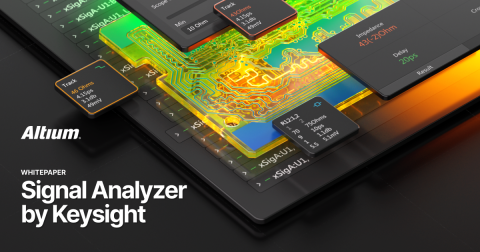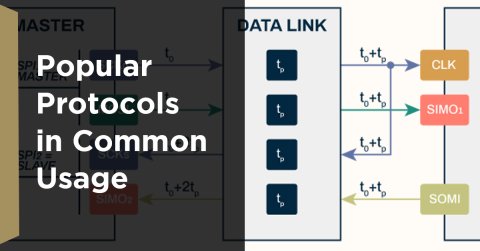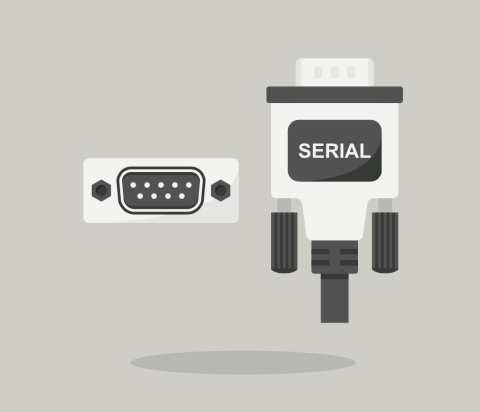How the Gibbs Phenomenon Produces Measurement Artifacts

Circuit simulations, signal simulations, and impulse response calculations often operate in an ideal world, where bandwidths aren’t limited or where singal artifacts aren’t observable in real measurements. Unfortunately, real interconnects and measurements are bandlimited, and this can create measurement artifacts that can create the appearance of a signal integrity problem like ground bounce, circulating reflection waves, or some level of resonance in short interconnects.
One important artifact is Gibbs ringing, something which was originally predicted in the 1840s. This artifact appears as spurious oscillations in measurements of an electrical signal or in time-domain responses calculated from band-limited measurements in the frequency domain. Gibbs ringing appears in areas beyond electronics design and interconnects, and it is a well-known problem in imaging (MRI, tomography, and Fourier optics). If you’ve ever looked at a low-quality JPEG image that has gone through several rounds of compression, the blotchy pixels around sharp edges in the image are a manifestation of Gibbs ringing.
Some sophisticated AI-based signal processing techniques have been developed specifically to remove Gibbs ringing from signal measurements and transforms, but you won’t have to use such extreme measures as a PCB designer. The Gibbs ringing phenomenon is most commonly encountered in two situations:
- Gathering band-limited measurements of a transmission line or RF interconnect
- Calculating a time-domain response from band-limited network parameters
In this article, we’ll look at the first point to see where we can get higher accuracy measurements by exploring the Gibbs phenomenon.
Gibbs Phenomenon and Ringing in Oscilloscope Measurements
When looking at an oscilloscope probe, you might see ringing on the rising edge, and possibly before the falling edge, of the signal being displayed on the screen. There are a few reasons why this might occur, which I’ll discuss momentarily. When testing a board, the designer’s goal is to distinguish a measurement artifact from a real signal integrity problem in an interconnect or a poorly compensated probe used for measurement.
Here’s an example of what you might measure with an oscilloscope. The leading edge of the signal exhibits some ringing:

The above graph shows an exaggerated example of what might be measured in a time-domain measurement. This ringing on the rising and falling edges is the Gibbs phenomenon (or simply Gibbs ringing), and it occurs because we’ve only summed up to the 7th harmonic of the fundamental frequency in the above example. No other signal integrity problems are present in the above example. If we were to sum up to the theoretical limit of infinite frequency for the above square wave, you would not see this ringing. This gives us our hint as to why we see ringing in a measurement: the measurement instrument cuts off some harmonics in the Fourier series of the square wave. In addition, there could be some other signal integrity problem that causes ringing in a real measurement, and this might be masked by Gibbs ringing.
Probably the most important feature in the above image is the rising underdamped oscillation that is seen before there is a signal transition! This means the signal has to anticipate the transition, something that is not physically realizable. Therefore, the Gibbs phenomenon is not something that actually happens in a band-limited channel, it’s a mathematical problem that could be easily mistaken for a real effect or could mask a real effect.
Measurement vs. Reality
The diagram below shows an example comparing an injected signal on a transmission line with the ideal response. The transmission line will slightly modify the injected signal and smooth out the signal due to the line and load capacitances. However, the measured signal might still exhibit ringing that is not really occurring on the transmission line. We generally don’t discuss this in PCB design because it occurs in sampling instruments and not due to a specific element on the PCB. However, it is important for a test engineer or an SI engineer to understand what might cause this and to determine if this is a real problem.

Obviously, if you want to measure a signal accurately, you want to avoid Gibbs ringing. How can this be done? Clearly, this is not something that can be filtered away, and in fact this is something that is caused by filtering. In general, we’re considering a transmission line, a short interconnect, or a testpoint connected to one of these. No matter how a signal is transferred from a driver component to some load, it is possible that the above ringing effect could occur in a measurement of that signal. Some of the reasons Gibbs ringing might occur in a measurement include:
- Nonlinear band-limiting in the channel
- Insufficient bandwidth in the probe
- Insufficient bandwidth in the scope
Just like measurement can modify a signal and produce the appearance of ringing, attempting to simulate the response of a circuit to certain inputs using model parameters will also produce apparent ringing. Matching the bandwidth of your signal with the bandwidth limits of a circuit and your model parameters are important here. To see how this works, let’s look at time-domain measurements first.
Bandwidth Matters in Time-Domain Measurements
Clearly, this is a problem of bandwidth, so you need to consider the frequency-domain bandwidth of your instrument when measuring a time-domain signal with an oscilloscope. It’s important to understand how an oscilloscope or other sampling instrument works. Analog oscilloscopes sum up frequency components from the input; they do not operate like an ADC. In contrast, digital oscilloscopes use a high sample rate ADC, with the best sampling rates exceeding 100 gigasamples/sec. In either case, the front-end functionality of the input will determine what artefacts arise during measurement:
- Analog oscilloscope: The input filtration and DSP stages in the design will produce ringing by cutting off frequency content in the input signal.
- Digital oscilloscope: These scopes use interpolation to reconstruct a signal Interpolation in the DSP stage will produce Gibbs ringing.
In either case, the front-end sampling circuitry in an oscilloscope is typically modeled as a higher-order filter circuit. This is not the way a real digital or analog receiver would work, but it’s a useful conceptual model as it helps explain bandwidth limiting in a real measurement. The image below shows a comparison of Butterworth responses in first-order and higher filter circuits, which can produce the ringing seen in a typical channel measurement.

Only the first-order filter will produce no ringing. All higher order filters will produce ringing in a measurement if their bandwidth is too close to the rise-time-bandwidth product for a digital signal. In general, you should opt to have a system bandwidth that is at least as large as the signal bandwidth using a Gaussian approximation for the input filtration stage for the scope:

Here, we’ve set the low-pass bandwidth to the inverse of the rise time for the digital signal you want to measure, which will provide plenty of headroom for your measurement. Note that, for a first-order filter, the signal bandwidth is 0.35 divided by the rise time (so-called knee frequency), but higher-order filters will have different values in the numerator. The typical rule of thumb is that your oscilloscope bandwidth should be double the signal bandwidth for the given filter order on your oscilloscope front-end, but setting the numerator to 1 provides about 3x bandwidth.
Physically Realizable Causes of Ringing
If you do have enough bandwidth in the probe and measurement unit, and you still see ringing, it could be due to the following:
- Parasitic inductance in the probe, test fixture, or probe connection to the board, which will have a specific oscillation period. Shifting the probe around can change this oscillation frequency.
- Ground bounce due to inductance back to the ground plane. This is determined entirely by the channel construction and produces ringing with specific oscillation frequency.
- Reflections, even in perfectly matched lines. At high portions of the channel bandwidth, this occurs due to load capacitance, which also sets a bandwidth limit in the channel.
- Extreme parasitics or unintended positive feedback along the length of the transmission line, such as in RF power systems involving passive or active amplification.
What Happens on Real Interconnects?
Now that we’ve looked at these important aspects of Gibbs ringing in time-domain measurements, we need to ask: what is actually happening on the interconnect? Does this ringing as defined by band-limiting actually occur when a signal travels on an interconnect and reaches a load component?
The transfer of energy along an interconnect does not generate real Gibbs ringing because Gibbs ringing is non-causal. Simply look at the first graph above, and you’ll see that the transient ringing produced on a signal transition happens before a falling or rising edge. We can also see what happens by looking at an equivalent circuit for an interconnect. Real interconnects are bandlimited and can be examined with the following circuit diagram:

From the above circuit, just by considering the load capacitance, we see that all transmission lines connect to a first-order filter (the input on the receiver), which will not produce any Gibbs ringing. Unfortunately, this is an incorrect assumption if you just assume that all transmission lines have the typical 50 Ohms characteristic impedance. The factors that will determine whether Gibbs ringing occurs at the load are:
- Transmission line parameters (copper roughness and dielectric dispersion)
- Linearity in the load input capacitances
- Component lead inductance
As a result, a real transmission line transfer function is approximately of fractional order, not of first order, depending primarily on the dispersion and roughness in the interconnect. This is an area where I’m actively involved in research and modeling, as well as parameter extraction from measurements. This all means that a bandlimited measurement, even with a fractional order transmission line, still requires headroom in the scope’s bandwidth.
In Summary
To summarize, Gibbs ringing is entirely an artifact of your measurement instrument and Fourier/Laplace transform operations on bandlimited network parameters. Hopefully the above explanation of signal behavior, transfer functions, and oscilloscope functionality will give you the tools needed to select the scope bandwidth you need (either 3 dB cutoff or Nyquist frequency). In summary, we have the following important conclusions:
- The Gibbs phenomenon is seen in the time-domain due to bandlimiting in higher-order filters
- When more high-frequency harmonics are present on the reconstructed time-domain signal, Gibbs ringing has reduced amplitude and faster decay
- Gibbs ringing can be reduced if your scope’s input filter/DSP stage bandwidth is large enough because
- A faster signal (shorter rise time) will have more power concentrated at higher frequencies, so a measurement of it requires more bandwidth in order to include more higher order harmonics and resolve the signal with suppressed Gibbs ringing
In an upcoming article, I’ll look at this from the corresponding frequency-domain perspective, where we want to predict a channel response to a given input and determine whether any ringing seen in a simulation is real or Gibbs ringing.
When you need to design, simulate, and layout your electronics while ensuring signal integrity and preventing the Gibbs phenomenon, use the complete set of PCB design, layout, and SPICE simulation features in Altium Designer®. When you need to extract network parameters from your interconnects and use these in simulations, you can use the EDB Exporter extension to import a design into Ansys field solvers and perform a range of SI/PI calculations. When you’ve finished your design, and you want to release files to your manufacturer, the Altium 365™ platform makes it easy to collaborate and share your projects.
We have only scratched the surface of what’s possible with Altium Designer on Altium 365. Start your free trial of Altium Designer + Altium 365 today.











